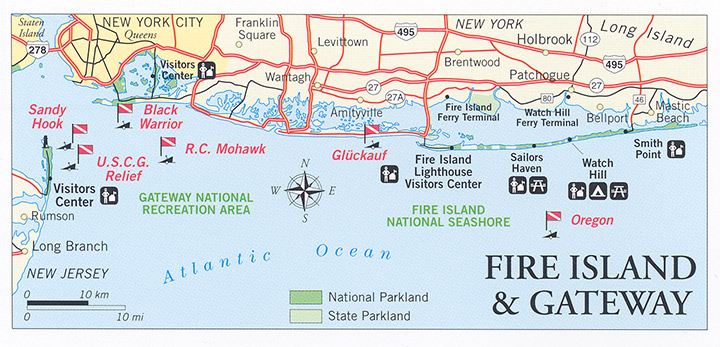Diving at Fire Island National Seashore
Fire Island, famous for its tranquil beauty, is a long narrow barrier-beach island, just off the eastern shore of Long Island. Two roads cross the inlet to connect each end of Fire Island to Long Island, but no roads run along the length. Many people travel here by ferry, to enjoy summerhouses and to experience the pristine beauty of 1,400 wilderness acres of beach and tidal marshlands.
Offshore lie some very famous wrecks, and one is actually buried in the sands that make up Fire Island's beach. The SS Savannah was the first steam auxiliary sailing vessel to make an ocean crossing. Another notable wreck well outside the park captured the imagination of the public in August 1984 when its safe, which had been recovered from the wreck by Peter Gimbel, was opened on national television: the Andrea Doria.
BASICS
Location: Southern shore of Long Island, NY
Skill level: Intermediate-advanced
Access: Limited diving by shore, unlimited by boat
Dive support: Bay Shore, Bohemia
Best time of year: Summer
Visibility: Poor to good (10 to 50 feet) Highlights: Shipwrecks
Concerns: Shore breakers, currents, pollution
Rules and Regulations
Dive Site Map

Dive Sites
ANDREA DORIA
Only a few of the local dive charter boats run trips out to the Andrea Doria as it is far enough out to require a multi-day trip. For a boat to stay on location over it the weather must be perfect. Because of its great depth, it is considered something of an inverted Denali in terms of adventure and effort in the minds of wreck divers. At a depth of 240 feet, this is definitely a triple-black-diamond dive suited only for experts.
The Andrea Doria, a 700-foot Italian luxury liner, sank in a dense fog on July 25, 1956, after colliding with the freighter Stockholm. Forty-six passengers were killed in this tragedy that by all rights should have been prevented. Both ships were radar equipped but deck officers, somehow managed to misinterpret the information on their radar screens. The ship rests intact on its starboard side. Ah, the safe, you ask? Not much was found in the safe except some U.S. Silver Certificates and some Italian bank notes.
OREGON
The Oregon was a 520-foot sail- and steam-powered transatlantic passenger liner that sank in March of 1886--the, Cunard line's first shipping disaster in some 43 years. This is a great dive despite the fact the ship has been heavily picked over by artifact hunters. At depths between 110 and 140 feet, it is an advanced dive. A member of the SRC once dived this site off the well-run charter boat Wahoo. Because he was the only non-local diver and the only one not familiar with the boat and the dive site both the crew and the other divers were very helpful in showing him the ropes. On the way to the site, a diver briefing him on what to expect made the comment that the wreck wasn’t as nice as it used to be. He figured that maybe storms had damaged the ship but, after arriving on the site, he immediately understood. There were already two other dive boats putting divers in the water. The divers off these boats and the Wahoo as well, resembled mechanics working in a junkyard auto parts depot. They carried every too imaginable: hacksaws, pneumatic tools, crowbars, wrenches, and anything else that could be useful in removing something from the wreck. On the bottom, it looked like bargain day at an underwater scrap yard; small groups of divers scattered around the wreck, hammering, sawing, chiseling and unbolting anything that they could remove. Soon, yellow lift bags were popping up around the boat like tulips in the spring. Each bag carried some piece of this once grand ship. Yup, the wreck isn't as nice as it used to be.
GLUCKAUF
This wreck is a shore dive that can be either a scuba dive or a snorkel. The Gluckauf was one of the first of the modern tankers specifically designed to carry petroleum across the Atlantic. It had tanks built into the hull, whereas previously ships carried petroleum in wooden kegs. The Gluckauf sank in 1893 when it was driven on to the outer bar by a fierce gale. After salvage tugs had freed it, their tow lines parted and the tanker washed over the bar and ended up on the beach. Parts of the ship are still exposed at low tide. This dive should be attempted only at a time when the surge and waves are minimal as there is substantial risk of being swept into jagged metal. Over the years, its has been mostly stripped by souvenir hunters. What remains of it now lies between the surface and about 25 feet of water. The visibility can be up to 20 feet. The remains are located just west of Davis Park and can be seen at low tide.
DIVING RULES AND REGULATIONS
Diver-down flag must be displayed while divers are in the water.
Removal of artifacts is strictly prohibited.
New York State Fish & Game regulations apply.
Last Updated: November 1, 2012





